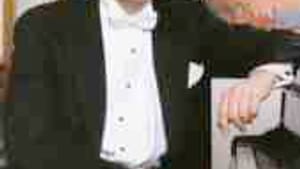Stay in the Loop
BSR publishes on a weekly schedule, with an email newsletter every Wednesday and Thursday morning. There’s no paywall, and subscribing is always free.
A family affair at Curtis
Peter Serkin at Curtis

It was a family affair at Curtis Sunday afternoon, with Peter Serkin (Class of '64) giving a benefit piano recital for the school that his father, the pianist Rudolf Serkin, once headed. Peter Serkin's sister was in attendance, as was his father's biographer, and the program included the Five Bagatelles (2001) of Peter's nephew, David Ludwig, himself a Curtis faculty member.
Serkin began his program with the Toccata of Stefan Wolpe, for some years a faculty member at Settlement Music School. It's actually a three-movement work, some 11 minutes long, whose Adagio middle movement is subtitled, "Too much suffering in the world." Wolpe himself saw enough of it as a refugee from Hitler in the 1930s.
The hard-driven opening Allegro Moderato owes much to Prokofiev's Toccata, Op. 11, as does virtually every exercise in the form since his day. But Bartok and Schoenberg can be felt in it too. The score provides little relief anywhere; the finale, a fugue, seems to end with a questioning phrase, only to be silenced with a hammering final chord.
Curtis magic
Charles Wuorinen's Adagio, a newly commissioned work, also sustains its seriousness throughout its quarter-hour length— and here, too, the silence that followed its final bars was profound.
David Ludwig's Bagatelles, an homage to Schoenberg's Pierrot Lunaire, offered more variety and even some playfulness but also epigrammatic substance in its individual pieces. Ludwig briefly introduced the work, and, after saluting his mother, warmly embraced his uncle at the end. The evident affection and mutual respect of both parties made the occasion more reminiscent of a student recital than a grand master performance; but then, that's the special magic of Curtis.
A great mind communing with itself
Serkin has made a specialty of the piece with which he concluded the program, Beethoven's Diabelli Variations. The piece was originally commissioned by the Viennese composer and publisher Anton Diabelli, who wished to put together a suite based on a waltz tune of his own composition by eminent Austrian composers, each of whom was to submit a single variation. Beethoven, probably seeing it as a profitable afternoon's work, agreed to participate.
What emerged, four years later, was a work that has no peer in the keyboard literature other than the Goldberg Variations. The single commissioned variation had become 33, and the tune meant for a dance floor had been taken to the empyrean.
Diabelli, in publishing the score, graciously admitted that Beethoven had given his melody a distinction Diabelli could never have conceived. Throughout it, but particularly in the three slow variations that precede the final fugue and minuet, we hear one of the greatest of human minds sublimely communing with itself— as close an approach to Plotinus's notion of the All alone with the All as is possible in art.
Serkin's reading fully met the challenges of the score, though a faint, tinny noise suggested a pedal that may have needed oiling. At an hour's length, the performance had considerable amplitude but no lack of dash and energy, and Serkin projected the episodes of Beethoven's Jovian humor with relish.
In fact— and for all the intellectual and physical force the piece calls on— Serkin appeared to be enjoying himself hugely. There's no surer mark of a mature artist at the height of his powers.
Serkin began his program with the Toccata of Stefan Wolpe, for some years a faculty member at Settlement Music School. It's actually a three-movement work, some 11 minutes long, whose Adagio middle movement is subtitled, "Too much suffering in the world." Wolpe himself saw enough of it as a refugee from Hitler in the 1930s.
The hard-driven opening Allegro Moderato owes much to Prokofiev's Toccata, Op. 11, as does virtually every exercise in the form since his day. But Bartok and Schoenberg can be felt in it too. The score provides little relief anywhere; the finale, a fugue, seems to end with a questioning phrase, only to be silenced with a hammering final chord.
Curtis magic
Charles Wuorinen's Adagio, a newly commissioned work, also sustains its seriousness throughout its quarter-hour length— and here, too, the silence that followed its final bars was profound.
David Ludwig's Bagatelles, an homage to Schoenberg's Pierrot Lunaire, offered more variety and even some playfulness but also epigrammatic substance in its individual pieces. Ludwig briefly introduced the work, and, after saluting his mother, warmly embraced his uncle at the end. The evident affection and mutual respect of both parties made the occasion more reminiscent of a student recital than a grand master performance; but then, that's the special magic of Curtis.
A great mind communing with itself
Serkin has made a specialty of the piece with which he concluded the program, Beethoven's Diabelli Variations. The piece was originally commissioned by the Viennese composer and publisher Anton Diabelli, who wished to put together a suite based on a waltz tune of his own composition by eminent Austrian composers, each of whom was to submit a single variation. Beethoven, probably seeing it as a profitable afternoon's work, agreed to participate.
What emerged, four years later, was a work that has no peer in the keyboard literature other than the Goldberg Variations. The single commissioned variation had become 33, and the tune meant for a dance floor had been taken to the empyrean.
Diabelli, in publishing the score, graciously admitted that Beethoven had given his melody a distinction Diabelli could never have conceived. Throughout it, but particularly in the three slow variations that precede the final fugue and minuet, we hear one of the greatest of human minds sublimely communing with itself— as close an approach to Plotinus's notion of the All alone with the All as is possible in art.
Serkin's reading fully met the challenges of the score, though a faint, tinny noise suggested a pedal that may have needed oiling. At an hour's length, the performance had considerable amplitude but no lack of dash and energy, and Serkin projected the episodes of Beethoven's Jovian humor with relish.
In fact— and for all the intellectual and physical force the piece calls on— Serkin appeared to be enjoying himself hugely. There's no surer mark of a mature artist at the height of his powers.
What, When, Where
Peter Serkin, piano recital: Wolpe, Toccata; Wuorinen, Adagio; Ludwig, Five Bagatelles; Beethoven, Thirty-three Variations on a Waltz by Anton Diabelli, Op. 120. January 29, 2012 at Field Concert Hall, Curtis Institute, 1726 Locust St. (215) 893-7902 or www.curtis.edu.
Sign up for our newsletter
All of the week's new articles, all in one place. Sign up for the free weekly BSR newsletters, and don't miss a conversation.
 Robert Zaller
Robert Zaller